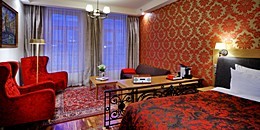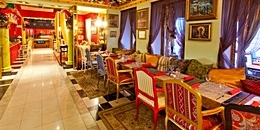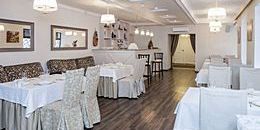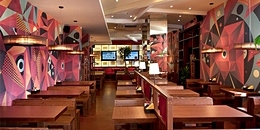Bolshoy Prospekt on Vasilevsky Island
The oldest and most important thoroughfare on Vasilyevsky Island, Bolshoy Prospekt is rich in historical sights from all three centuries of St. Petersburg's existence. Originally conceived as a shipping canal, hence its width of over 85m, it was turned in the 19th century into a green boulevard - one of only a handful in St. Petersburg. Over the centuries, the avenue has been home to merchants and noblemen, a large community of Lutheran Germans, army families, and of course the teachers and students of the nearby St. Petersburg State University.

The road that came to be known as Bolshoy Prospekt first appeared on Vasilyevsky Island - then called Preobrazhensky Ostrov ("Transfiguration Island") - in the 1710s. It was Peter the Great's chief adviser, Grand Prince Alexander Menshikov, who ordered a road to be cleared from his palace to the coast of the Gulf of Finland. The road turned out to be so convenient that, when the architect Domenico Trezzini came to plan the layout of Vasilevsky Island, he decided to use the road as the central thoroughfare. It was then known as Bolshoy Kanal ("Grand Canal") as the whole island was supposed to be laced with a network of canals in the style of Amsterdam or Venice. However, Peter the Great's plans to get the whole of St. Petersburg travelling in boats never proved popular with the residents of the new city, and the broad street was eventually renamed as Bolshaya Pershpektiva - "Grand Avenue".

Between 1730 and 1760, the avenue slowly extended east into the heart of the island, becoming lined with wooden buildings. The western end of the avenue became the home of St. Petersburg's German community, who built the Lutheran Church of St. Catherine from 1768 to 1771. At the same time a few hundred meters away, Alexander Vist, an architect of German origin, was overseeing the construction of the Cathedral of St. Andrew (on the site of an older wooden church). In the 1780s, the avenue was paved and started to be called Bolshoy Prospekt. The Andreevsky Market, one of the first stone trade buildings in St. Petersburg, was also built during that decade.

At the beginning of the 19th century, green spaces began to appear along the avenue. At first they were private property, but were soon taken over by the city. The density of the foliage was such that contemporaries said it was as if they were walking through a park, as the buildings were barely visible through the leaves. By the 1830s, however, taller buildings had begun to appear along the street. Among the most interesting are the Soloshich Building, the Junker Building, the Alezander Bryullov Building, and the riding school of the Finnish Regiment. At various times, the famous residents of Bolshoy Prospekt include the writers Fyodr Dostoevsky and Nikolay Chernyshevsky, the artists Ilya Repin and Nicholas Roerich, the leading physiologist Ivan Sechenov, and Alexander Voyeykov, the founder and pioneer of climatology in Russia. In the 1870s, streetcar tracks were laid along the avenue, while in 1868, the first kindergarten in St. Petersburg was opened at No. 17/16.

By the beginning of the 20th century, the street had been built up as far as 25-ya Liniya. The buildings lining the avenue included works of some of St. Petersburg's most famous architects, many of Germanj descent, including Leontiy Benois, Viktor Schroter, Vasiliy Schaub, Ludwig Sporer, Karl Schmidt, Karl Anderson, and Nikolay Katzenelnbogen. In the 1890s, the neo-Byzantine Church of the Merciful Mother of God was erected at the intersection of Bolshoy Prospekt and 25-ya Liniya. After the Revolution, the church was turned into a swimming pool to train rescue divers.
From 1917 onwards, Bolshoy Prospekt became the administrative and social centre of the district. It was the site of the District Committee of the Communist Party, and then the District Soviet. The avenue was renamed Prospekt Proletarskoy Pobedy - "Avenue of the Victory of the Proletariat". During the 1930s, it became home to the Vasileostrovsky Communal Kitchen and the S. M. Kirov Palace of Culture - both examples of Stalinist constructivism. During the Siege of Leningrad (1941-1944), No. 6 was home to the Savichev family, where the teenage Tanya Savicheva wrote her harrowing diary of the siege, which would later become famous throughout the world. In 1944, the avenue was given back its historic name, although with the letters VO - Vasilevskiy Ostrov - always added to prevent confusion with the other Bolshoy Prospekt on the Petrograd Side.

For over 50 years, the red-brick building at No. 73, which housed the district fire station at the turn of the 20th century, has been home to the Exhibition of Firefighting Technology, where visitors can discover the history of firefighting in St. Petersburg.
By 1982, the avenue had been extended west to Ploshchad Morskoy Slavy, thus making it run from almost one end of the island to the other. Today, alongside Universitetskaya Naberezhnaya, Bolshoy Prospekt VO is one of the main tourist routes around Vasilevsky Ostrov.
| Metro stations: | Vasileostrovskaya |
|---|---|
| Best walking route: | The historic section of the avenue from 1-ya Liniya to 25-ya Liniya (1.9km) |
| What's here? | Lutheran Church of St. Catherine, Cathedral of St. Andrew, Andreevsky Market, S. M. Kirov Palace of Culture, Russian Academy of Science's Institute of High Molecular Compounds, Ludwig Sporer Apartment Building, Vasiliy Schaub Apartment Building, Hospital of Stock-Exchange Merchants, Katzenelnbogen Apartment Building, Church of the Merciful Mother of God |
| What's nearby? | 1-ya Liniya / Kadetskaya Liniya, 6-ya / 7-ya Liniya, Neva River |







